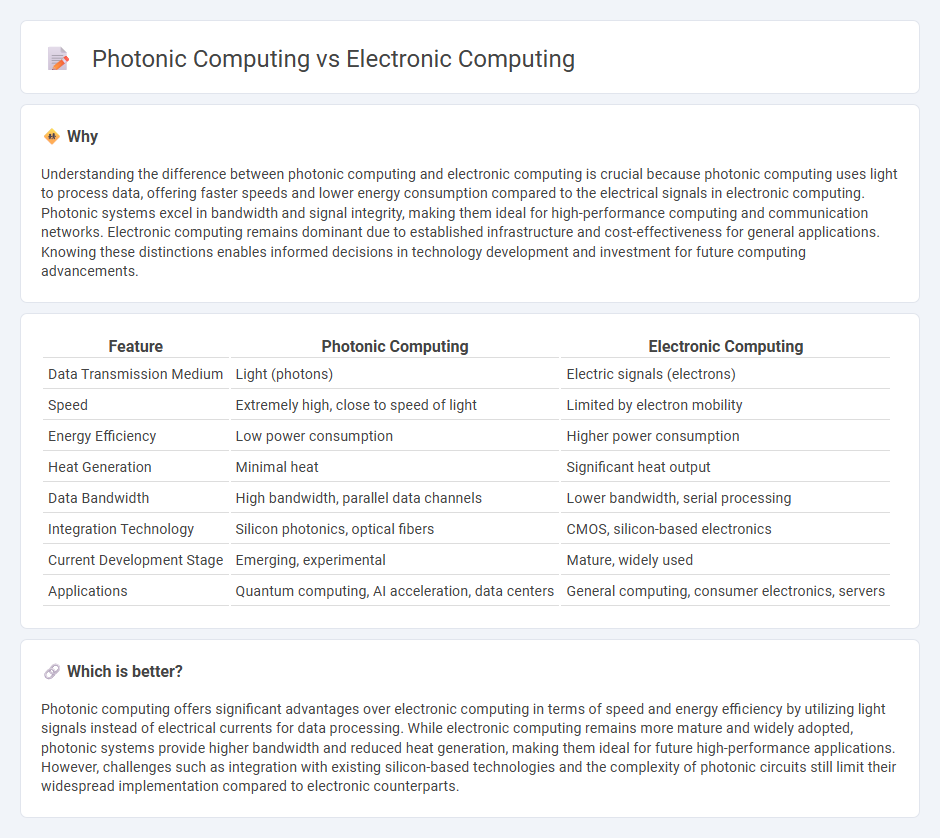
Photonic computing utilizes light particles called photons for data processing, offering significantly faster speeds and lower energy consumption compared to traditional electronic computing, which relies on electrons. This emerging technology promises enhanced bandwidth and reduced heat generation, making it ideal for high-performance computing tasks and large-scale data centers. Explore the advancements and implications of photonic computing to understand its potential impact on the future of technology.
Why it is important
Understanding the difference between photonic computing and electronic computing is crucial because photonic computing uses light to process data, offering faster speeds and lower energy consumption compared to the electrical signals in electronic computing. Photonic systems excel in bandwidth and signal integrity, making them ideal for high-performance computing and communication networks. Electronic computing remains dominant due to established infrastructure and cost-effectiveness for general applications. Knowing these distinctions enables informed decisions in technology development and investment for future computing advancements.
Comparison Table
| Feature | Photonic Computing | Electronic Computing |
|---|---|---|
| Data Transmission Medium | Light (photons) | Electric signals (electrons) |
| Speed | Extremely high, close to speed of light | Limited by electron mobility |
| Energy Efficiency | Low power consumption | Higher power consumption |
| Heat Generation | Minimal heat | Significant heat output |
| Data Bandwidth | High bandwidth, parallel data channels | Lower bandwidth, serial processing |
| Integration Technology | Silicon photonics, optical fibers | CMOS, silicon-based electronics |
| Current Development Stage | Emerging, experimental | Mature, widely used |
| Applications | Quantum computing, AI acceleration, data centers | General computing, consumer electronics, servers |
Which is better?
Photonic computing offers significant advantages over electronic computing in terms of speed and energy efficiency by utilizing light signals instead of electrical currents for data processing. While electronic computing remains more mature and widely adopted, photonic systems provide higher bandwidth and reduced heat generation, making them ideal for future high-performance applications. However, challenges such as integration with existing silicon-based technologies and the complexity of photonic circuits still limit their widespread implementation compared to electronic counterparts.
Connection
Photonic computing and electronic computing are interconnected through hybrid systems that leverage the speed of light for data transmission while using electronic components for processing and control functions. Photonic components, such as waveguides and modulators, convert electronic signals into optical signals and vice versa, enabling seamless integration between optical and electronic domains. This synergy enhances overall computing performance, reducing latency and power consumption in applications like data centers and communication networks.
Key Terms
Source and External Links
Electronic Computing: Crash Course Computer Science #2 - The first programmable electronic computer was the Colossus, used for code-breaking with vacuum tube technology, followed by ENIAC in 1946, the first general-purpose, programmable electronic computer that performed thousands of operations per second but suffered frequent vacuum tube failures.
Computer - Wikipedia - Colossus, the first electronic programmable computer, used valves (vacuum tubes) and was followed by ENIAC, which was faster, Turing-complete, and programmable through switches and plugboards but required manual setup.
Digital computer | Evolution, Components, & Features - Britannica - ENIAC, developed by Eckert and Mauchly in 1946, was the first general-purpose electronic computer replacing relays with vacuum tubes, which greatly increased speed, leading to the concept of stored-program computers soon after with EDVAC.
 dowidth.com
dowidth.com